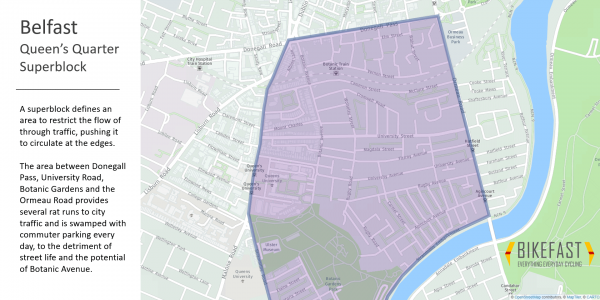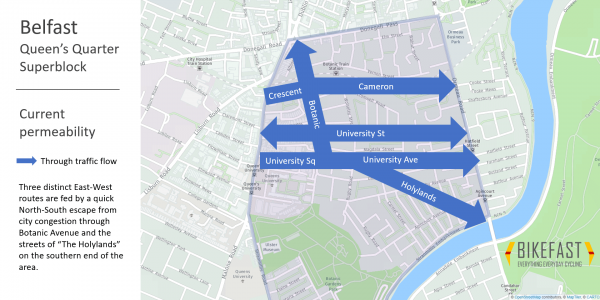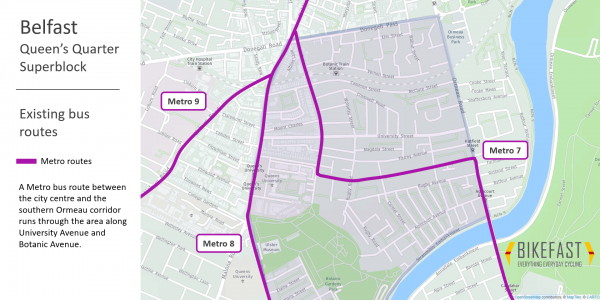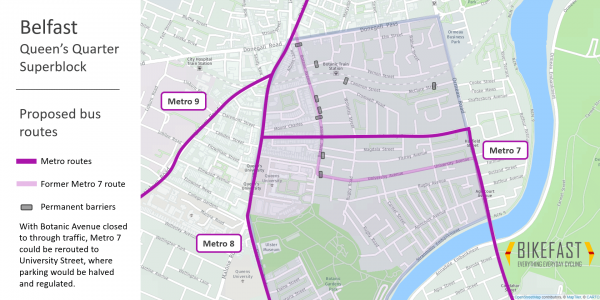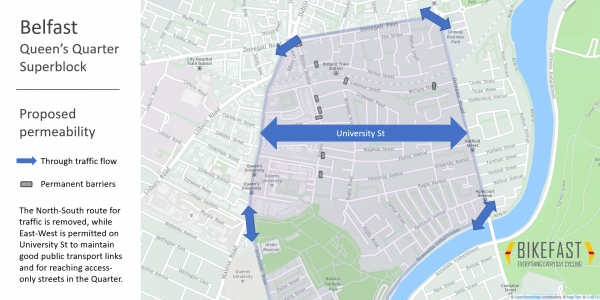Following Infrastructure Minister Nichola Mallon’s announcement of a new Walking and Cycling Champion, to lead the emergency measures needed to immediately increase active travel space and priority, we take a closer look at one aspect of plans: superblocks.
The term has been used to describe work to reduce traffic levels within areas of Barcelona, and Bikefast has proposed a superblock-style approach to re-configuring Belfast’s Linen Quarter.
Coronavirus has claimed many lives and devastated families, and will continue to do so – in greater numbers if we are unable to manage social distancing requirements in whatever the emergence from lockdown looks like. Communities have seen one small ray of light in the last two months of sacrifice and stress – a huge increase in walking and cycling within their immediate areas.
It’s been widely recognised that enabling this to continue would be good for public health, the environment, more liveable places and critically in the short to medium term, getting people to safely access and support local small businesses and community hubs when they begin to reopen.
The new normal may mean less vehicle access to city centres, widened pavements and pop-up bike lanes on arterial streets. But many communities will have seen the benefit of living without the usual volumes of through-traffic, and wish to prevent a return.
An example of how this could be simply achieved is demonstrated with the Queen’s Quarter.
The area is bounded by Donegall Pass to the north, University Road to the west, Botanic Gardens and the Lagan to the south and the Ormeau Road to the east.
The area is blighted by traffic and daily commuter parking. Only a handful of one-way streets (eg College Square, The Crescent, The Holylands) and access-only streets (eg Mount Charles) prevent area-wide unfettered access. A residents’ parking scheme has been in place on Rugby Road and College Park Avenue since 2018.
The easy permeability is one of the main issues. Three distinct East-West routes are fed by a quick North-South escape from city congestion through Botanic Avenue and the streets of “The Holylands” on the southern end of the area.
A Metro bus route between the city centre and the southern Ormeau corridor runs through the area along University Avenue and Botanic Avenue. The southern extension of the “Glider” bus rapid transit system is due to run along the length of the Ormeau Road in a few years.
How to create the superblock
A handful of minor road closures and barriers to vehicle access could fundamentally change the area. Snipping University Street beside the Union Theological College would cut off the popular eastbound rat run along University Square to the Ormeau Road.

University Street closed at the Union Theological College during Ciclovia Belfast
Raising barriers to vehicles on several other streets would leave Botanic Avenue as a traffic-free plaza, with residents’ vehicle access possible throughout the approach streets.
Botanic Avenue suffers from being a quasi arterial corridor, despite only linking to other more strategic arterials. The only real justification is the Metro 7 bus route, which links with Botanic railway station. Without through-traffic, the cafes, restaurants, hotels and independent shops could flourish with the surrounding high density resident population, daily influx of university students and its nightlife venues.

Botanic Avenue during Ciclovia – this section could be permanently pedestrianised
Smaller access-only streets would have virtually no traffic movements allowing for easy walking and cycling at comfortable distance.

Molly’s Yard and Dukes could extend outwards in this closed section of Botanic Avenue
A more generously spaced and safer cycleway could be created along University Square by removing one side of (free) parking, with the other side regulated to encourage the use of alternative travel and churn.

A poorly designed ‘door-zone’ contraflow cycle lane runs along on University Square
Cameron Street is deluged with (free) commuter parking every day, adding to city congestion. Closing it up, apart from residents and business access at either end, would reduce congestion and allow a much-needed inner city greenway-style park to be developed instead.

Free commuter parking floods Cameron Street every day – gone by tea time
With Botanic Avenue closed to through-traffic, Metro 7 could be rerouted along University Street, where parking would be halved and regulated.
Having the Metro 7 route turning between the Quarter and the Ormeau Road on a signal controlled junction, instead of patiently waiting for a break in rush hour traffic emerging from University Street, would improve journey reliability.
Instead of high permeability with North-South route and three East-West routes, the superblock plan would drastically cut through-traffic access and volumes.
The North-South route for traffic is completely removed, while East-West is travel is permitted on University Street to maintain good public transport links and for reaching access-only streets in the Quarter. This is also to ensure balance of East-West travel to ensure flows are not simply displaced onto Donegall Pass. Close monitoring would assess any impact in the short term and further calming measures could be deployed is needed.
The superblock idea takes damaging traffic off unsuitable streets and passes it around the edges. A reduction in overall vehicle levels could be seen too as people adjust to new route planning, alternative options, and a parking supply which is reduced and better controlled. Residents’ parking schemes would need to cover the whole area to ensure that residents and local businesses and their visitors are prioritised.
It’s just a concept, to demonstrate the types of interventions which areas of Belfast other towns and cities around the country could benefit from. Is there a potential superblock sitting in plain sight in your area? Let us know.


